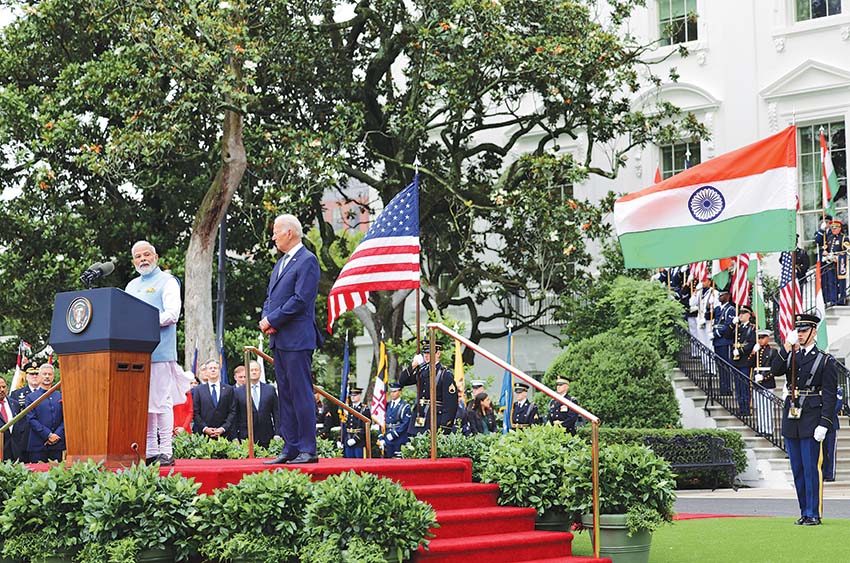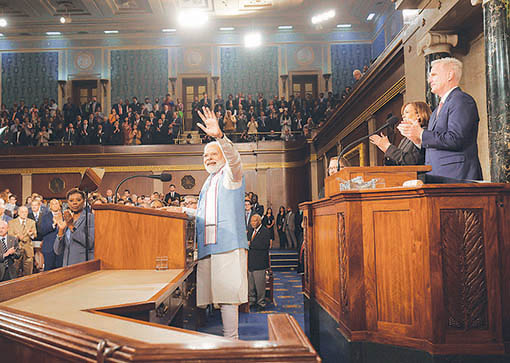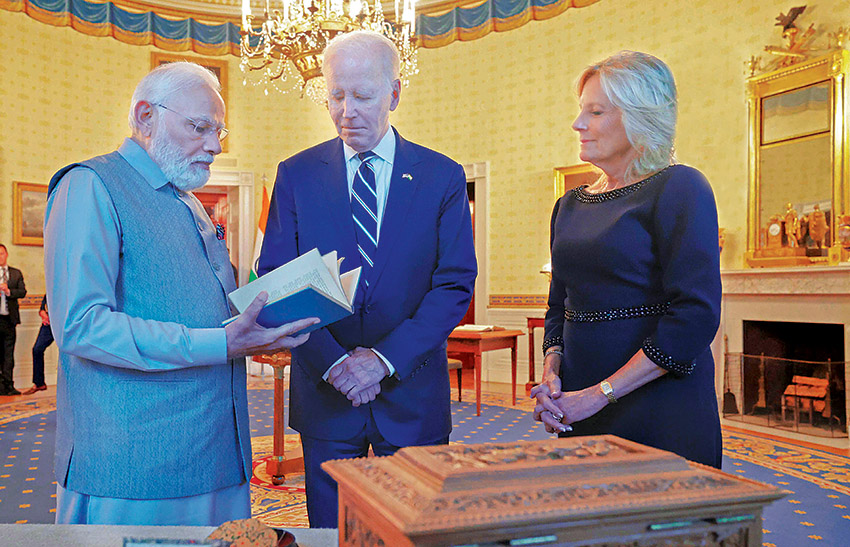Modi in US
Strategic Partnership affirmed across diverse fields, from the Seas to Space
Modi Addresses US Congress for the second time, a rare distinction for a visiting Prime Minister
Washington D.C. Prime Minister Narendra Modi travelled to the United States during the last week of June this year. The four-day sojourn marked many firsts in a series of engagements that were the highlights of the State visit accorded by President Joseph Biden’s administration to him.

The depth and sweep of interactions Prime Minister Modi held during the Washington journey underscored the deep importance the US has been attaching to India over the recent years, particularly under the leadership of Narendra Modi.
A ceremonial welcome, a State dinner and a rare honour bestowed upon him to address the joint sitting of the United States Congress, for a second time, brought to fore the deep and growing ties characterised as strategic partnership.
The India-United States ties are spread across some 50 sectors and literally straddle between Space and Sea. These engagements have grown deeper over the decade and acquired a new heft in terms of defence and security relations. In fact, many of the advanced systems, particularly fighter, transport and ISR (Intelligence, Surveillance and Reconnaissance) aircraft are from the US Boeing, Lockheed Martin and Raytheon, and airlines from India, Air India and Indigo for instance, are factoring a rather huge number of civil aircraft like Boeing 787s and 777s from the US.
There were many takeaways from the visit on strategic, defence, security and scientific fields and it clearly demonstrated the importance the current leadership in Washington attached to India and PM Modi. India’s relations with the United States have enjoyed bipartisan support both with successive administrations and the US Congress, with both the Democrats and Republicans advocating for increased ties. During the last nine years, PM Modi interacted with three successive Presidents, two from the Democratic Party and one from the Republicans.
PM Modi began by heralding a major event at the United Nations Headquarters in New York to celebrate the International Yoga Day on June 21. The occasion was both symbolic and a gentle reminder of the ancient art of Yoga and India’s contribution in sharing this ancient knowledge of health and consciousness with the world. It was the UN that in 2015 declared June 21 as the International Day of Yoga and for the past few years, enthusiasts of this regime have undertaken exercises in the backdrop of historic locations throughout the world. This year a bonus came India’s way in the form of the Guinness World Record for maximum participation by people of different nationalities at the lawns of UNHQ.

State Visit
By the time the scene shifted to Washington DC, the programme reflected the lengths to which the Biden administration went to treat its guest both in the form of pomp and ceremonials, and substantive discussions to enhance the relationship whose trajectory is witnessing an upward swing. Ahead of the official State dinner, PM Modi was hosted by the first couple to a private meeting at the White House while of official dinner became the talk of the town much before it was held. In fact, a few days ahead of the event, President Biden in half-jest told PM Modi that the White House was besieged with requests for attending the dinner in his honour.
In another gesture, the Biden administration invited several hundred Indian Americans to witness the official ceremony to receive PM Modi at the White House.
Decisive Speed in building and implementing Agreements
The official leaders-level discussion appreciated the speed with which both the countries made progress in new areas such as Critical and Emerging Technologies and to work together for strategic technology collaborations to build resilient supply chains.
Critical Materials and Supply Chains
Ever since the global Corona virus health pandemic, there is an increasing realisation in the world of the need to develop alternate global supply chains. The strategy was to reduce the dependence on China, which controls major medicinal and equipment supply chains across the globe, and shift these to other countries so that there would be no major disruptions experienced in the Covid and post-Covid era. This found mention during PM Modi’s address to the Congress when he talked of over-concentration of supply chains as a consequence of globalisation.
“We will work together to diversify, decentralise and democratise supply chains” he noted adding that technology would determine the security, prosperity and leadership in the 21st Century which led both India and the United States to establish a new ‘Initiative for Critical and Emerging Technologies’.
“Our knowledge partnership will serve the humanity and seek solutions to the global challenges of climate change, hunger and health.”
While work to create and shift shop-floors remains in progress, India and the United States also decided to deepen cooperation in Critical Minerals and Space sectors besides working together to combat climate change, achieve a sustainable future and promote clean and renewable energy. Among the key decisions was the US promise to help India increase production of electric vehicles as the country works to meet its target of installing 500 gigawatts of Wind, Solar and other renewable energy by 2030.

US and Indian Investments
In another significant development, Micron Technology, the US memory chip firm, promised to invest $ 8.25 million to set up a new chip assembly and testing plant in Gujarat. This will be the first Micron factory in India.
Yet, investments were not just one way. India too offered to do its share as Vikram Solar Limited, an Indian solar panel manufacturer, decided to invest up to $ 1.5 billion in the US solar energy supply chain.
Space
Taking forward the cooperation in the space sector, India agreed to join the significant US-led Artemis Accord on space exploration.
Established in 2020 by the US State Department and the US space agency, NASA, the Accord aims to build upon the foundations of the 1967 Outer Space Treaty. Besides the US, seven countries including Australia, Canada, Italy, Japan, Luxembourg, the United Arab Emirates and the United Kingdom are the founding members.
The objective is to set common principles that would govern exploration and use of outer space, the Moon, Mars, and comets for civil and peaceful purposes. India will also work with NASA on a joint mission to the International Space Station (ISS) next year. The earlier cooperation between NASA and Indian Space Agency, ISRO had led to the success of Chandrayaan-1 in 2008 which led to the discovery of water on the surface. The radar for the mission was made by Raytheon and given to ISRO through an academic exchange programme.
Address to the US Congress
PM Modi, who first addressed the joint sitting in June 2016, had the rare honour to be invited by the bi-partisan leadership to share his thoughts with the law-makers.

The India story on the Capitol Hill is one continuous tale of deep support to this changing nature of relationship. The strong and deep-rooted ties between the oldest and largest democracies in the world have continued to thrive and cut across political divides on either side of the aisle. Irrespective of the party that controls the Congress, or either the House of Representatives or the Senate, India remains a special flavour.
Despite some periodic statements on issues on events in India, lawmakers from both the Democratic Party and the Republicans continue to advocate the need to build and sustain the robustness in relations with India.
Now, for the past couple of years the thrust of important Members of the Congress is to encourage the United States to expand its military relationships with New Delhi.
Two critical technologies being shared with India are the General Atomics MQ 9B Predators/ Sea Guardians for the Three Services with both ISR and Strike capabilities, and the GE F114 engines for HAL’s Light Combat Aircraft Mk II and later, maybe the Advanced Medium Combat Aircraft (AMCA).





